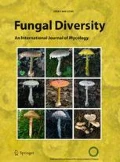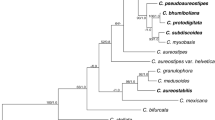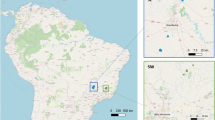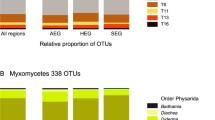Abstract
The dictyostelid social amoebae (Dictyostelia) occur in terrestrial habitats worldwide. It has been observed previously that their diversity decreases with increasing latitude and altitude. Here we look at dictyostelid diversity in the high latitude habitats of Northern Sweden. Dictyostelids were recovered from soil samples using traditional plating methods and then identified using morphological characters and molecular sequence (small subunit ribosomal RNA) data. In total, nine species were recovered, including two new species, described herein as Dictyostelium barbibulus and Polysphondylium fuscans. The species diversity found here is discussed in relation to previous findings in the area as well as other high-latitude studies, and biogeographical patterns are examined. The total number of species found in Northern Sweden is lower than the numbers recorded for regions further south in Europe, a finding consistent with a latitudinal gradient of species diversity. Our findings highlight the benefit of using molecular data for accurate species identification in Dictyostelia and the need for a continued sampling effort to better understand their diversity and distribution, especially in high latitude habitats.





Similar content being viewed by others
References
Arnborg T (1990) Forest types of northern Sweden. Vegetatio 90:1–13
Bass D, Richards TA, Matthai L, Marsh V, Cavalier-Smith T (2007) DNA evidence for global dispersal and probable endemicity of protozoa. BMC Evol Biol 7:162. doi:10.1186/1471-2148-7-162
Bloomfield G, Skelton J, Ivens A, Tanaka Y, Kay RR (2010) Sex determination in the social amoeba Dictyostelium discoideum. Science 330:1533–1536
Boenigk J, Ereshefsky M, Hoef-Emden K, Mallet J, Bass D (2012) Concepts in protistology: species definitions and boundaries. Eur J Protistol 48:96–102
Bonner JT (2009) The Social Amoebae. Princeton University Press, Princeton, New Jersey
Brefeld O (1869) Dictyostelium mucoroides. Ein neuer Organismus und der Verwandschaft der Myxomyceten. Abh Seckenburg Naturforsch Ges 7:85–107
Brefeld O (1884) Polysphondylium violaceum und Dictyostelium mucoroides nebst Bemerküngen zur Systematik der Schleimpilze. Unters Gesammtgeb Mykol 6:1–34
Cavender JC (1973) Geographical distribution of the Acrasieae. Mycologia 65:1044–1054
Cavender JC (1978) Cellular slime molds in tundra and forest soils of Alaska including a new species, Dictyostelium septentrionalis. Can J Bot 56:1326–1332
Cavender JC, Raper KB (1965) The Acrasieae in nature I. Isolation. Am J Bot 52:294–296
Cavender JC, Raper KB, Norberg AM (1979) Dictyostelium aureo-stipes and Dictyostelium tenue: new species of the Dictyosteliaceae. Am J Bot 66:207–217
Cavender JC, Cavender-Bares J, Hohl HR (1995) Ecological distribution of cellular slime molds in forest soils of Germany. Bot Helv 105:199–219
Coccuci SM, Sussman M (1970) RNA in cytoplasmic and nuclear fractions of cellular slime mold amoebae. J Cell Biol 45:399–407
Eisenberg RM, Francis D (1977) The breeding system of Polysphondylium pallidum, a cellular slime mold. J Eukaryot Microbiol 24:182–183
Epstein S, Lopez-Garcia P (2008) “Missing” protists: a molecular perspective. Biodivers Conserv 17:261–276
Erdos GW, Raper KB, Vogen LK (1973) Mating types and macrocyst formation in Dictyostelium discoideum. Proc Nat Acad Sci USA 70:1828–1830
Fenchel T, Finlay BJ (2004) The ubiquity of small species: patterns of local and global diversity. Bioscience 54:777–784
Fenchel T (2005) Cosmopolitan microbes and their ‘cryptic’ species. Aquat Microb Ecol 41:49–54
Foissner W (2006) Biogeography and dispersal of micro-organisms: a review emphasizing protists. Acta Protozool 45:111–136
Frøyen OJ, Langvad F (1984a) Description of dictyostelid cellular slime mold species in Norway. Nord J Bot 4:503–511
Frøyen OJ, Langvad F (1984b) Occurrence and distribution dictyostelid cellular slime mold species in Norway. Nord J Bot 4:817–821
Hagiwara H (1979) The Acrasiales in Japan. V Bull Natl Sci Museum Ser B (Bot) 5:67–72
Hagiwara H (1982) Altitudinal distribution of dictyostelid cellular slime mold in Gosainkund region of Nepal. In: Otani Y (ed) Reports on the cryptogamic study in Nepal. National Science Museum, Tokyo, pp 105–117
Hagiwara H (1989) The taxonomic study of Japanese dictyostelid cellular slime molds. National Science Museum, Tokyo
Hagiwara H (1990) Altitudinal distribution of dictyostelid cellular slime molds in the Langtang Valley of Central Himalayas. Rept Tottori Mycol Inst 28:191–198
Heidel AJ, Lawal HM, Felder M, Schilde C, Helps NR, Tunggal B, Rivero F, John U, Schleicher M, Eichinger L, Platzer M, Noegel AA, Schaap P, Glöckner G (2011) Phylogeny-wide analysis of social amoeba genomes highlights ancient origins for complex intercellular communication. Genome Res 21:1882–1891
Hillebrand H (2004) On the generality of the latitudinal diversity gradient. Am Nat 163:192–211
Kawabe K (1995) Distribution of dictyostelid cellular slime molds in forest soils of Sweden. Bull Jap Soc Microbiol Ecol 10:115–118
Kottek M, Grieser J, Beck C, Rudolf B, Franz R (2006) World map of the Köppen-Geiger climate classification updated. Meteorol Z 15:259–263
Landolt JC, Stephenson SL, Laursen GA, Densmore R (1992) Distribution patterns of cellular slime molds in the Kantishna Hills, Denali National Park and Preserve, Alaska, U.S.A. Arctic Alpine Res 24:244–248
Medlin L, Elwood HJ, Stickel S, Sogin ML (1988) The characterization of enzymatically amplified eukaryotic 16S-like rRNA-coding regions. Gene 71:491–499
Mehdiabadi NJ, Kronforst MR, Queller DC, Strassmann JE (2009) Phylogeny, reproductive isolation and kin recognition in the social amoeba Dictyostelium purpureum. Evolution 63:542–548
Mehdiabadi NJ, Kronforst MR, Queller DC, Strassmann JE (2010) Phylogeography and sexual macrocyst formation in the social amoeba Dictyostelium giganteum. BMC Evol Bio 10:17. doi:10.1186/1471-2148-10-17
Norberg AM (1971) The Dictyostelium mucoroides complex. Dissertation, University of Wisconsin
Nylander JAA (2004) MrModeltest 2.4. Program distributed by the author. Evolutionary Biology Center, Uppsala University, Sweden
Olive EW (1901) A preliminary enumeration of the Sorophoreae. Proc Am Acad Arts Sci 34:333–344
Palm BT (1935) Ett fynd av Dictyostelium mucoroides i Sydsverige. Sven Bot Tidskr 29:365–366
Perrigo AL, Romeralo M, Baldauf S (2012) What’s on your boots: an investigation into the role we play in protist dispersal. J Biogeogr 36:998–1003
Raper KB (1984) The Dictyostelids. Princeton University Press, Princeton
Romeralo M, Lado C (2006) Dictyostelids from Mediterranean forests of the south of Europe. Mycol Progress 5:231–241
Romeralo M, Fiz-Palacios O, Lado C, Cavender JC (2007) A new concept for Dictyostelium sphaerocephalum based on morphology and phylogenetic analysis of nuclear ribosomal internal transcribed spacer region sequences. Can J Bot 85:104–110
Romeralo M, Baldauf SL, Cavender JC (2009) A new species of cellular slime mold from southern Portugal based on morphology, ITS and SSU sequences. Mycologia 101:269–274
Romeralo M, Landolt JC, Cavender JC, Laursen GA, Baldauf SL (2010) Two new species of dictyostelis cellular slime molds from Alaska. Mycologia 102:588–595
Romeralo M, Cavender JC, Landolt JC, Stephenson SL, Baldauf SL (2011a) An expanded phylogeny of social amoebas (Dictyostelia) shows increasing diversity and new morphological patterns. BMC Evol Biol 11:84. doi:10.1186/1471-2148-11-84
Romeralo M, Moya-Larano J, Lado C (2011b) Social amoebae: environmental factors influencing their distribution and diversity across south-western Europe. Microbial Ecol 61:154–165
Romeralo M, Escalante R, Baldauf SL (2012) Evolution and diversity of dictyostelid social amoebae. Protist 163:327–343
Ronquist F, Huelsenbeck JP (2003) MrBayes 3: Bayesian phylogenetic inference under mixed models. Bioinformatics 19:1572–1574
Schaap P, Winckler T, Nelson M, Alvarez-Curto E, Elgie B, Hagiwara H, Cavender J, Milano-Curto A, Rozen DE, Dingermann T, Mutzel R, Baldauf SL (2006) Molecular phylogeny and evolution of morphology in the social amoebas. Science 314:661–663
Staden R (1996) The Staden sequence analysis package. Mol Biotechnol 5:233–241
Stamatakis A, Hoover P, Rougemont J (2008) A rapid bootstrap algorithm for the RAxML web servers. Syst Bio 75:758–771
Stephenson SL, Landolt JC, Laurson GA (1991) Cellular slime molds in soils of Alaskan tundra, U.S.A. Arctic Alpine Res 23:104–107
Stephenson SL, Landolt JC, Laurson GA (1997) Dictyostelid cellular slime molds from western Alaska, U.S.A. and the Russian Far East. Arctic Alpine Res 29:222–225
Sucgang R, Kuo A, Tian X, Salerno W, Parikh A, Feasley CL, Dalin E, Tu H, Huang E, Barry K, Lundquist E, Shapiro H, Bruce D, Schmutz J, Salamov A, Fey P, Gaudet P, Anjard C, Babu MM, Basu S, Bushmanova Y, van der Wel H, Katoh-Kurasawa M, Dinh C, Coutinho PM, Saito T, Elias M, Schaap P, Kay RR, Henrissat B, Eichinger L, Rivero F, Putnam NH, West CM, Loomis WF, Chisholm RL, Shaulsky G, Strassmann JE, Queller DC, Kuspa A, Grigoriev IV (2011) Comparative genomics of the social amoebae Dictyostelium discoideum and Dictyostelium purpureum. Genome Biol 12:R20. doi:10.1186/gb-2011-12-2-r20
Swanson AR, Vadell EM, Cavender JC (1999) Global distribution of forest soil dictyostelids. J Biogeogr 26:133–148
Traub F, Hohl HR, Cavender JC (1981) Cellular slime molds of Switzerland. II. Distribution in forest soils. Am J Bot 68:172–182
Vadell EM, Cavender JC (1998) Polysphondylium from forest soils of Tikal, Guatamala. Mycologia 90:715–725
Vadell EM, Cavender JC, Romeralo M, Edwards SM, Stephenson SL, Baldauf SL (2011) New species of dictyostelids from Patagonia and Tierra del Fuego. Mycologia 103:101–117
Wilkinson DM (2001) What is the upper limit for cosmopolitan distribution in free-living microorganisms? J Biogeogr 28:285–291
Willig MR, Kaufman DM, Stevens RD (2003) Latitudinal gradients of biodiversity: patterns, processes, scale and synthesis. Annu Rev Ecol Evol Syst 34:273–309
Acknowledgments
The authors would like to thank Mats Thulin for assistance with species descriptions. We would like to express our appreciation to the people at the dictyBase Stock Center (Northwestern University, Chicago, Illinois) for maintaining dictyostelid voucher specimens, including those described in this paper. Financial support from the foundations Signhild Engkvists Stiftelse and Lars Hierts Minne to ALP is gratefully acknowledged. MR is supported by a Marie Curie Intra-European Fellowship within the 7th European Community Framework Programme (PIEF-GA-2009-236501).
Author information
Authors and Affiliations
Corresponding author
Rights and permissions
About this article
Cite this article
Perrigo, A.L., Baldauf, S.L. & Romeralo, M. Diversity of dictyostelid social amoebae in high latitude habitats of Northern Sweden. Fungal Diversity 58, 185–198 (2013). https://doi.org/10.1007/s13225-012-0208-3
Received:
Accepted:
Published:
Issue Date:
DOI: https://doi.org/10.1007/s13225-012-0208-3




